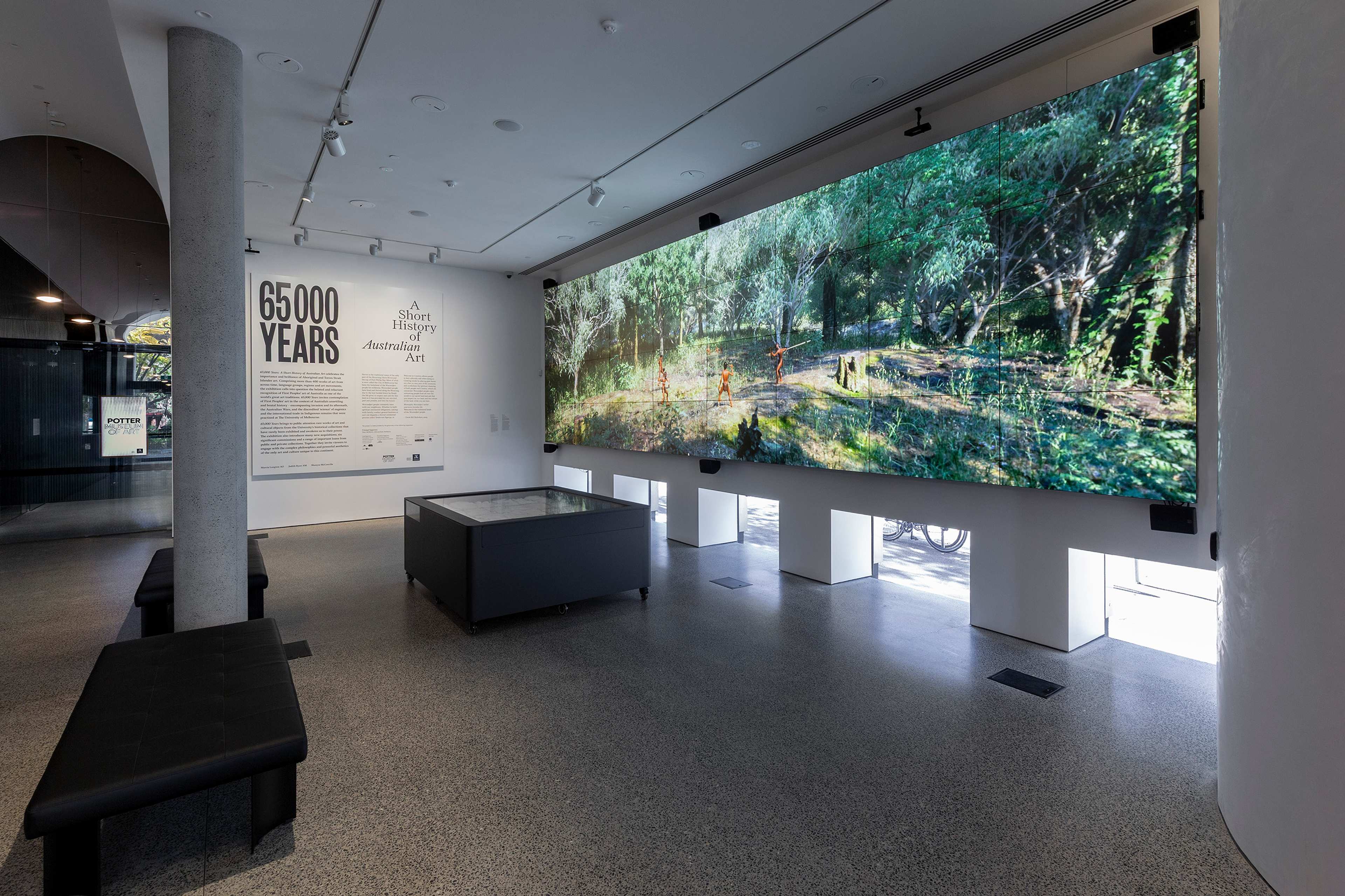65,000 Years: A Short History of Australian Art Commissions

Installation view of 65,000 Years: A Short History of Australian Art, Potter Museum of Art, the University of Melbourne, 2025. Featuring Brett Leavy, Virtual Naarm 1834. commissioned by the University of Melbourne, 2023; Mandy Nicholson, Possum skin cloak 2012, commissioned by Melbourne Medical School by the University of Melbourne. Photography by Christian Capurro.
As part of 65,000 Years: A Short History of Australian Art, the University of Melbourne commissioned six new artworks that celebrate the continuum of Indigenous culture and artistic practice across the continent. These works respond to and expand onthe works held in the University of Melbourne’s historical collections and more than 70 other collections represented across the exhibition. Each new commission speaks to unique Indigenous histories of custodianship, resistance, and endurance.
Brett Leavy
Virtual Narrm 1834, 2025
Brett Leavy’s Virtual Songlines project reimagines the Indigenous spiritual and cultural sites that once stood where towns and cities now exist through close, considered collaboration with traditional custodians. He works alongside historians, designers, developers and programmers to animate these stories, representing life and Country prior to European colonisation. For Virtual Narrm 1834, Leavy has collaborated with the Wurundjeri Woi Wurrung Cultural Heritage Aboriginal Corporation to represent the stories, lands, and waterways of Narrm. This work celebrates Wurudjeri custodianship of Country since time immemorial and invites us to immerse ourselves in the experience and perspective of traditional custodians, journeying through the native bushlands that once covered this city.
Julie Gough
The Missing, 2024
Julie Gough’s practice explores hidden and conflicting histories, often drawing upon her own and her family’s experience as Tasmanian Aboriginal people. This newly commissioned work responds to the University of Melbourne's late nineteenth-century plaster casts of Nununi leaders Wurati and Trukanini, first modelled by artist Benjamin Law in Nipaluna (Hobart) in 1835–36. As part of Gough’s research she visited multiple institutions across Australia and internationally that hold reproductions of these busts and filmed them where they are held. There are likely to be several more pairs held by other institutions across the world. The resulting video work is, as Gough puts it ‘incompletable,’ owing to the fact that it is impossible to know with certainty how many of these casts were produced and where they have been dispersed across the world. Through this work, Gough reflects on the displacement of Aboriginal cultural objects, Ancestors, and people from Country.
Betty Muffler and Maringka Burton
NgangkariNgura (Healing Country), 2022
Betty Muffler and Maringka Burton are Anangu ngangkari (traditional healers) living at Indulkana, South Australia in the APY Lands. Their collaborative painting, NgangkariNgura (Healing Country) is a sprawling, large-scale work that tells the stories of each artist’s experiences as ngangkari caring for Anangu and for Country. Aunty and niece, Muffler and Burton have worked together and separately as ngangkari throughout their lives, and have more recently begun working collaboratively in their painting practices as well. In this newly commissioned work, they draw attention to the plight of the land at Maralinga and Emu Field—sites of British nuclear weapons testing in the 1950’s. These tests caused extensive ongoing impacts to the land and resulted in the displacement of traditional custodians. Painting their stories together, Muffler and Burton illuminate the sacredness of Country, the ongoing ancestral connections that Anangu have to it, and the urgent need to heal and care for the land.
Lorraine Connelly-Northey
Narrbong-galang (String bags), 2024
Lorraine Connelly-Northey’s works reflect on the ongoing effects of colonisation on Indigenous people and lands. She creates work from discarded materials such as scrap metal—waste from colonisation and industrialisation—to create sculptural works that represent the traditional knowledge and culture of Indigenous people. This newly commissioned work recreates monumental sculptural narrbong-galang(string bags) woven from abandoned pieces of rusted metal and wire the artist has reclaimed. Connelly-Northey emphasises that she only takes what she needs from the land, both in her life and in her art practice, and in turn highlights the destructive force of colonisation and its impacts on Country and Aboriginal people.
Sandra Aitken
Gnarraban (Eel basket), 2023
Sandra Aitken is an artist of Gunditjmara descent based in Victoria. She learned to weave from her aunt, respected Elder Aunty Connie Hart. Hart’s mother, Frances Alberts, had learned the practice from Jennie Green, her husband’s grandmother. However, she had been prevented from teaching any traditional practices to her children by mission managers who would not allow for this important cultural knowledge to be passed down. However, Hart had observed her mother weaving, and revived the practice, teaching this skill to Aitken and her cousins in the early 1980’s. Sandra has created a large Gnarraban (eel trap) made from Puung’ort (spear) grass for this exhibition; a fish trapping system used by her ancestors for thousands of years.
Vicki West
Water carriers, 2023
Baskets, 2023
Vicki West is senior Trawlwoolway artist who has made a series of six works commissioned by the University including three water carriers and three baskets. West’s water carriers are made from kalikina (bull kelp), representing the continuation of a material practice unique to Lutruwita (Tasmania). This significant material has long been utilised by Tasmanian Aboriginal people as a food source and also for a variety of objects including balls for practice spear throwing, shoes, and for safety cover from sharks when diving. Similarly, West’s baskets woven from river reed use an S-twist technique that is also specific to Lutruwita. These works point to the endurance of Indigenous traditions in the face of colonial violence and celebrate the survival of West’s people.
